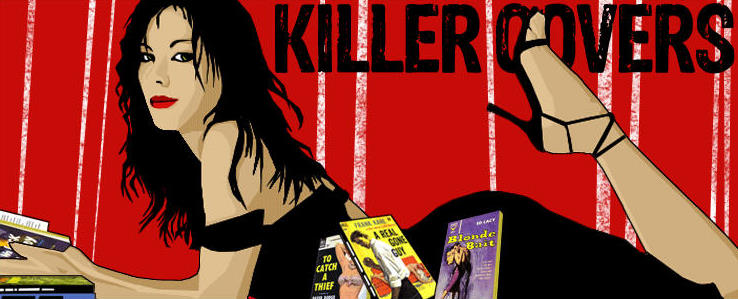 Yours truly, J. Kingston Pierce, with sometime co-authors Barbara and Max Allan Collins at Bouchercon in Raleigh.
(Editor’s note: One of the genuine delights of my attending this month’s Bouchercon convention in Raleigh, North Carolina, was seeing author Max Allan Collins and his wife, Barbara. I first interviewed Max, a resident of Muscatine, Iowa, way back in 1999, but have since had many more opportunities to quiz him about his fiction. And whenever we both find ourselves at Bouchercon, he and I manage to catch up a bit on what’s new in our respective lives. When I saw him in Raleigh, I also asked Max if he could write a short article for Killer Covers about how he had managed to secure Robert McGinnis-painted fronts--shown below--for all five of the Quarry novels Hard Case Crime plans to reissue between now and March of 2016. His not-so-short explanation follows.)
Yours truly, J. Kingston Pierce, with sometime co-authors Barbara and Max Allan Collins at Bouchercon in Raleigh.
(Editor’s note: One of the genuine delights of my attending this month’s Bouchercon convention in Raleigh, North Carolina, was seeing author Max Allan Collins and his wife, Barbara. I first interviewed Max, a resident of Muscatine, Iowa, way back in 1999, but have since had many more opportunities to quiz him about his fiction. And whenever we both find ourselves at Bouchercon, he and I manage to catch up a bit on what’s new in our respective lives. When I saw him in Raleigh, I also asked Max if he could write a short article for Killer Covers about how he had managed to secure Robert McGinnis-painted fronts--shown below--for all five of the Quarry novels Hard Case Crime plans to reissue between now and March of 2016. His not-so-short explanation follows.)
Like many baby-boomer males around my age, I looked in awe at the wonderfully lurid paperback covers riding the spinner racks at newsstands, bookshops, and drug stores. As an aspiring writer since age 13, I dreamed of one day having beautiful cover paintings like those of
Robert McGinnis, James Avati, Barye Phillips, and Robert Maguire adorn my novels.
Alas (I’ll spare you the “alack”), by the time my first paperbacks began appearing in the early ’70s, those glorious paintings were replaced by cheaper (and cheap-looking) photography. This approach doomed
Bait Money,
Blood Money,
The Broker,
The Broker’s Wife,
The Dealer, and
The Slasher to covers that labeled the product within as mediocre. Later, when Pinnacle reprinted
Bait and
Blood and published more of my
Nolan novels,

they used men’s adventure-style paintings, which were much better if not quite what I’d dreamed of. And in the mid-’80s, when
The Broker became
Quarry (and the other three Quarry novels became
Quarry’s List,
Quarry’s Deal, and
Quarry’s Cut) at Foul Play Press, the publisher utilized cool but very modern, almost abstract covers. Still better than cheap photography.
Cut to decades later, when editor-writer
Charles Ardai began publishing the
Hard Case Crime line, with covers that evoked the grand old style. Unfortunately, when Charles published a reprint of
Bait and
Blood under the joint title
Two for the Money, the cover was one of the weakest in the Hard Case lineup (and it still is). Charles, who was publishing some of his own novels with Hard Case, had meanwhile enlisted the legendary Robert McGinnis for his covers.
So when Charles called me in 2006 (or it may have been 2005) and asked if I might write
a new Quarry novel for him--the previous one (
Primary Target, aka
Quarry’s Vote) having appeared in the mid-’80s--I said I’d write the book on one condition.
That Robert McGinnis did the cover painting.
Charles, bless him, made that happen. Since then there have been another half-dozen Quarry novels, the most current of which (
Quarry’s Choice) also sports a McGinnis cover, as does my Spillane collaboration,
The Consummata. There’s also been a
feature film, and now a
Quarry TV series is poised to
begin airing in early 2016.
To tie-in with the TV show, Charles thought that Hard Case Crime republishing the first five Quarry novels--at the time only available as print-on-demand titles (and e-book)--might be a good idea. I thought it was a great idea. I’d never had a chance to review the text of the novels (I’d never seen galley proofs of the first four) and create definitive editions.
The only problem was that the books would have to be published quickly, to take full advantage of the Cinemax series. And of course Hard Case Crime is famous for its magnificently pulpy covers, which don’t happen overnight. In addition, there were no promo photos from the TV show available yet--it was still filming.
So I suggested we approach Robert McGinnis and see if he had any appropriate paintings (i.e., of beautiful girls) in his inventory. After many decades of work, he surely had a few put away.
Charles approached the great man, and indeed he did have several such paintings in inventory.
Five.
I studied the paintings and arranged them to match up to the novels (mostly the hair color of the beauties dictated that).
Which is how I managed to gain five more McGinnis covers in one fell swoop. And no other writer of my generation can boast as many--counting the as-yet-unwritten
Quarry on Target, that will make nine.
I only wish I could whisper in that 13-year-old’s ear, as he spun the paperback rack at Cohn’s Newsland in Muscatine, that his wishes were going to come true.



 (Top photo © 2015 by Ali Karim)
READ MORE:
(Top photo © 2015 by Ali Karim)
READ MORE: “
The Early Quarry Novels of Max Allan Collins,”
by Tom Callahan (Graphic Novel Reporter).





















